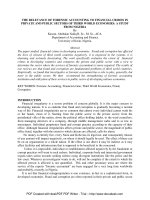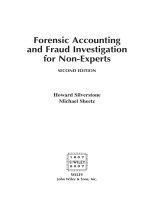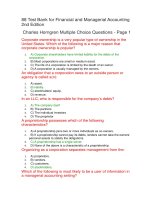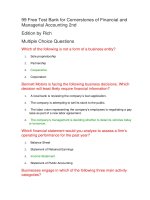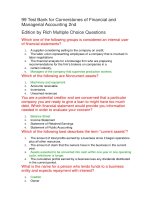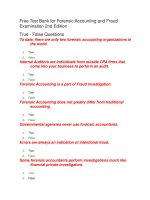Financial investigation and forensic accounting 2nd
Bạn đang xem bản rút gọn của tài liệu. Xem và tải ngay bản đầy đủ của tài liệu tại đây (14.76 MB, 601 trang )
FINANCIAL
INVESTIGATION
and
FORENSIC
ACCOUNTING
Second Edition
George A. Manning, Ph.D., C.F.E., E.A.
2223 CIP Page 1 Tuesday, January 18, 2005 11:48 AM
Published in 2005 by
CRC Press
Taylor & Francis Group
6000 Broken Sound Parkway NW
Boca Raton, FL 33487-2742
© 2005 by Taylor & Francis Group
CRC Press is an imprint of Taylor & Francis Group
No claim to original U.S. Government works
Printed in the United States of America on acid-free paper
10 9 8 7 6 5 4 3 2 1
International Standard Book Number-10: 0-8493-2223-5 (Hardcover)
Library of Congress Card Number 2004058536
This book contains information obtained from authentic and highly regarded sources. Reprinted material is quoted with
permission, and sources are indicated. A wide variety of references are listed. Reasonable efforts have been made to publish
reliable data and information, but the author and the publisher cannot assume responsibility for the validity of all materials
or for the consequences of their use.
No part of this book may be reprinted, reproduced, transmitted, or utilized in any form by any electronic, mechanical, or
other means, now known or hereafter invented, including photocopying, microfilming, and recording, or in any information
storage or retrieval system, without written permission from the publishers.
For permission to photocopy or use material electronically from this work, please access www.copyright.com
( or contact the Copyright Clearance Center, Inc. (CCC) 222 Rosewood Drive, Danvers, MA
01923, 978-750-8400. CCC is a not-for-profit organization that provides licenses and registration for a variety of users. For
organizations that have been granted a photocopy license by the CCC, a separate system of payment has been arranged.
Trademark Notice: Product or corporate names may be trademarks or registered trademarks, and are used only for
identification and explanation without intent to infringe.
Library of Congress Cataloging-in-Publication Data
Manning, George, A.
Financial investigation and forensic accounting / by George A. Manning.--2nd ed.
p. cm.
Includes bibliographical references and index.
ISBN 0-8493-2223-5 (alk. paper)
1. White collar crime investigation--United States. 2. Forensic accounting--United States.
3. Fraud investigation--United States. I. Title.
HV8079.W47M35 2005
363.25'963--dc22
2004058536
Visit the Taylor & Francis Web site at
Taylor & Francis Group
is the Academic Division of T&F Informa plc.
and the CRC Press Web site at
Dedication
In Loving Memory, to my wife, Lois E. Manning,
who passed away suddenly in 2002.
She was a very loving and devoted wife and mother of two children.
iii
Preface
Forensic accounting can be defined as the science of gathering and presenting financial
information in a form that will be accepted by a court of jurisprudence against perpetrators
of economic crimes.
Economic crimes have increased dramatically in recent years. This becomes evident
in viewing newspaper reports, which on an almost daily basis report of economic crimes
committed in communities across the country. One can read of a person embezzling funds
from a bank or company, a political person accepting kickbacks for political favors, a con
artist who swindles people out of money by fraudulent schemes, or a person selling illegal
products (drugs, alcohol, or tobacco).
Law enforcement personnel in recent years have become more aware of white-collar
crimes. However, they have lacked the training and expertise in combating such crimes.
This is particularly true for small police departments. The law enforcement community
today is better trained at combating violent or personal behavior crimes, but now it has
the responsibility to expand its knowledge and expertise into the economic crimes area.
In order to do this, law enforcement must receive further education and training. Many
police departments, both small and large, focus their resources on violent crimes. Since
many detectives do not have an accounting background, they often fail to use financial
information to support their cases. This is particularly true in organized crime and drug
trafficking cases. Congress and some states have enacted laws for law enforcement to use
financial information to support their cases. Some large police departments have employed
accountants to help law enforcement develop financial information, but they are relatively
few. One South Florida police department with over 2000 sworn officers has only one
accountant, and he is swamped with cases. Some police departments will contract an
accountant for a case, but this is rare.
The accounting profession is beginning to change from examination for irregularities
to examination for fraud on the part of employees and management. Some of the largest
bankruptcies have occurred during the last 5 years because management has been “cooking
the books” to hide their skimming of huge amounts of funds from public corporations.
This has resulted in many investors losing their life savings or retirement nest eggs. This,
of course, has resulted in a change of audit procedures to encompass external third-party
inquiries as well as internal audit procedures. Financial institutions and credit reporting
agencies are becoming more involved with business organizations’ financial affairs by
requiring more disclosures. They are developing more techniques to uncover potential
fraudulent schemes by developing profiles, which will identify perpetrators before huge
losses are incurred by other businesses.
The cooperation of accountants and law enforcement has now become not just important but imperative. Accountants must know what financial data are admissible in a court
v
of law. The criminal investigator must learn how to use financial information to enhance
his case.
The following illustration gives an example of what the results can be when law
enforcement personnel do not have the training and knowledge to use financial information.
A police department in South Florida obtained a search warrant for a car dealership
suspected of dealing in drugs. The officers went in and discovered large amounts of cocaine,
money, jewelry, precious metals, and financial files. The police officers confiscated the
cocaine, money, jewelry, and precious metals, but left the financial files behind. In a
forfeiture hearing, the defendants claimed that the jewelry and precious metals did not
belong to them and provided witnesses who testified that the jewelry and precious metals
were being held on consignment. The court ruled in favor of the defendants, and several
days later, the defendants got on a flight out of the country with the jewelry and precious
metals in their possession. It was later learned that the jewelry and precious metals were
purchased from various vendors in the city. The estimated cost of the jewelry and precious
metals was $1.8 million. The drug traffickers removed their laundered money out of the
country by buying jewelry and precious metals since no Treasury Currency and Monetary
Instrument Reports (CMIRs) were required at the time. The police would not have lost
the jewelry and precious metals if they had confiscated the financial records, which clearly
showed how the defendants purchased the commodities.
Accountants in both public practice and industry must recognize financial crimes at
an early stage and document such crimes for judicial prosecution. Most accountants do
not recognize fraud. Business people do not recognize fraud schemes until it is too late.
The following illustration shows how a business became a victim even when advised of
the situation.
A major supplier of appliances had a policy of granting liberal credit terms to new
businesses. A new appliance store took advantage by ordering a nominal amount of
appliances. The new store regularly ordered appliances at an increasing rate using the
liberal credit terms. The controller noticed that the rate of increase was above normal. The
management of the supplier disregarded the controller’s concern. After about 9 months,
the new store placed an $800,000 order, and since the new store paid its bills on time, the
order was shipped. The management of the new store received the $800,000 order and the
next day shipped its entire inventory to another location some 300 miles away. When the
supplier sent notices to the new store for payment, the notices first came back marked
“unclaimed” and later came backed marked “moved with no forwarding address.” When
the supplier sent collectors out to the new store, they found the building empty. The new
store owners disposed of the inventory for $1.5 million and the supplier suffered a loss of
$800,000, which took 5 years to recover by raising prices by 10%. The supplier unsuccessfully sued the new store. Law enforcement would not proceed against the store owners
because they concluded that the new store owners were merely bad businessmen. Actually,
law enforcement did not know how to prosecute this kind of crime.
The purpose of this book is twofold. First, it should be used as a reference guide by
law enforcement and accountants. This book is written so the reader can find specific issues
and learn how to investigate and present them in a court of law. Second, it can be used as
a textbook in training both law enforcement and accountants in the field of fraud examination and forensic accounting.
This book is focused upon practical, everyday use by both law enforcement and
accountants. Theory is also addressed, but it is explained more in terms of everyday use.
Another objective is to make accountants familiar with law enforcement and the law, and
law enforcement familiar with the importance of financial information in both civil and
criminal cases. It has been made very clear that when a team of both accountants and
criminal investigators team up, they rarely lose a criminal case. Also, they learn the interrelationships and needs of each other.
A trend across this country today is the declining budgets of law enforcement agencies
at all levels of government. At the same time, violent crime is on the increase and is expected
to increase much more in the future. Public opinion today is for law enforcement to go
after violent criminals. Violent crime is on television every day, but white-collar crimes
are rarely reported. If this trend continues, then law enforcement will be unable to provide
the personnel and other resources needed to investigate white-collar criminals. The FBI
reported in the 1990s that violent crime makes up 95% of all cases, while white-collar
crime only makes up 5%. Yet, white-collar crime is responsible for 95% of the financial
losses suffered by victims.
The security industry has had tremendous growth in recent years. It has made a great
demand for security locks, various types of alarms, and security guards. Private investigation firms have also shown tremendous growth, particularly in matters relating to civil
litigations, searching for hidden assets, and tracing funds. Some law enforcement agencies
have retained private fraud examiners in their investigations. If this trend continues, and
the outlook is that it will, fraud examiners will be in greater demand in the future.
The Author
Dr. George A. Manning, Ph.D., C.F.E., E.A., is retired from working as a fraud examiner,
forensic accountant, and expert/summary witness for the Internal Revenue Service. He has
a Bachelor’s Degree in Business Administration from the University of Miami, Florida,
and a Master of Science and Doctor of Philosophy Degrees in Criminal Justice Administration from Lynn University, Boca Raton, Florida. He is a certified fraud examiner and is
enrolled to practice before the Internal Revenue Service (enrolled agent). He has worked
with various federal, state, and local law enforcement agencies. He has 22 years’ experience
in the fraud investigation and forensic accounting field. He currently does consulting work
and works as an adjunct professor.
ix
Acknowledgments
A special thanks to Cynthia Weeks for her assistance with my research and writing. Her
many hours spent researching in the library and on the Internet, as well as performing
secretarial duties, are greatly appreciated.
xi
Table of Contents
Exhibits ..................................................................................................................xv
Tables.................................................................................................................. xvii
Figures.................................................................................................................. xix
Chapter 1 Economics of Crime................................................................................1
Chapter 2 Financial Crimes ...................................................................................15
Chapter 3 Offshore Activities ................................................................................37
Chapter 4 Evidence ................................................................................................65
Chapter 5 Net Worth Theory .................................................................................81
Chapter 6 Expenditure Theory...............................................................................97
Chapter 7 Scenario Case ......................................................................................105
Chapter 8 RICO Net Worth Solution...................................................................119
Chapter 9 Tax Net Worth Solution ......................................................................131
Chapter 10 RICO Expenditure Solution ..............................................................143
Chapter 11 Tax Expenditure Solution..................................................................155
Chapter 12 Organized Crime ...............................................................................167
Chapter 13 Trial Preparation and Testimony.......................................................203
Chapter 14 Accounting and Audit Techniques....................................................209
Chapter 15 Sources of Information......................................................................223
Chapter 16 Wagering and Gambling ...................................................................245
xiii
Chapter 17 Fraud Prevention for Consumers.......................................................281
Chapter 18 Fraud Prevention for Businesses .......................................................297
Chapter 19 Money Laundering ............................................................................309
Chapter 20 Interviewing ......................................................................................371
Chapter 21 Banking and Finance.........................................................................383
Chapter 22 Reports and Case Files ......................................................................399
Chapter 23 Audit Programs .................................................................................419
Chapter 24 Seizures and Forfeitures ....................................................................441
Chapter 25 Judicial System..................................................................................447
Chapter 26 Criminology ......................................................................................461
Chapter 27 Physical Security ...............................................................................473
Chapter 28 Search Warrants ................................................................................491
Chapter 29 Computer Crimes ..............................................................................503
Chapter 30 Fraud Examiner .................................................................................515
Appendix A: Federal Reserve Districts and American Bankers
Association Numerical System ...................................................................523
Appendix B: Money Laundering Acronyms.......................................................527
Appendix C: Internet Sources of Information ....................................................529
Appendix D: Internet Country Codes .................................................................539
Appendix E: Glossary of Common Internet Terms ............................................545
Bibliography ........................................................................................................551
Suggested Reading and References ....................................................................553
Index ....................................................................................................................555
Exhibits
19.1
Form 104 (formerly 4789), Currency Transaction Report
19.2
Form 105 (formerly 4790), Report of International Transportation of Currency or
Monetary Instruments
19.3
Form 8300, Report of Cash Payments over $10,000
19.4
Form TDF 90-22.1, Report of Foreign Bank and Financial Accounts
19.5
Form 8362, Currency Transaction Report by Casinos
19.6
Form TD F 90-22.55, Registration of Money Services Business
19.7
Form 3520, Annual Return to Report Transactions with Foreign Trusts and Receipt
of Certain Foreign Gifts
19.8
Suspicious Activity Report
21.1
Sample Check
xv
Tables
8.1
John Doe’s RICO Net Worth Schedule (Title 18)
8.2
RICO Net Worth Schedule Adjustment for Offshore Activities
9.1
John Doe’s Tax Net Worth Schedule (Title 26)
9.2
John Doe’s Tax Net Worth Adjustments for Offshore Activities (Title 26)
10.1
John Doe’s RICO Expenditure Schedule (Title 18)
10.2
John Doe’s RICO Expenditure Schedule Adjustments with Offshore Activities
(Title 18)
11.1
John Doe’s Tax Expenditure Schedule (Title 26)
11.2
John Doe’s Tax Expenditure Schedule with Adjustments for Offshore
Activities (Title 26)
14.1
John Doe’s Tracing Schedule
xvii
Figures
5.1
Tax Net Worth Theory
5.2
RICO Net Worth Theory
6.1
Tax Expenditure Theory
6.2
RICO Expenditure Theory
14.1
Gross Profit Analysis Schedule
14.2
Bank Deposit Method
14.3
Organization Flowchart
14.4
Telephone Matrix
14.5
Operational Flowchart
16.1
Lottery Organization Chart
16.2
Winning Bingo Card
16.3
Sample Bingo Paper Invoice
22.1
Witness and Exhibit List
22.2
Investigation Report
22.3
Table of Contents Sample
22.4
Net Worth Schedule Witness List
22.5
Index of Interviews/Depositions
22.6
Memorandum of Interview Sample
22.7
Statement Sample
23.1
Cash Flow Statement
xix
1
Economics of Crime
1.1 Introduction
The effects of crime act upon the economy in two primary ways. Microeconomics deals
with the effect on individuals and businesses. Macroeconomics deals with the effect on
the local community, national, and international economies. Individuals and businesses
can easily understand the effect of crime in their everyday activities. However, most individuals and businesses have difficulty understanding the effect of crime on the community,
national, and international levels.
1.2 Cost Reality
The cost of crime on the economy in the U.S. is now at a staggering height. The outlook
does not look any better. There is no real compensation for emotional and social harms
done to members of a society by criminal acts. The average citizen would be shocked to
know the actual costs. There are no consolidated figures as to the total cost of crime.
However, if all the various costs were compiled into a consolidated figure, then they would
surely be enormous. The cost of crime involves all of the following elements:
1. Law enforcement. This encompasses the cost of training and maintaining a police
department and all of its support staff, equipment, buildings, etc.
2. Crime prevention. This involves all the community programs that try to help
prevent crime. Common programs include Crime Stoppers, school programs, and
various other programs sponsored by local community tax dollars.
3. Drug prevention and rehabilitation. This involves both public and private financing. Both government and private organizations offer programs to prevent and
rehabilitate drug and alcoholic offenders. This costs money to both the taxpayers
and the patients.
4. Incarceration. It costs the taxpayers a lot of money to house, supervise, train, feed,
clothe, and provide medical care for inmates in a jail or detention center.
5. Courts. Operating and maintaining the court system costs the taxpayers many tax
dollars. It involves judges, court reporters, clerks, buildings, etc.
1
2
Financial Investigation and Forensic Accounting, 2nd Edition
6. Prosecutors. The costs of employing prosecutors and their staffs, buildings, and
all of the associated costs of operating and maintaining them are enormous, especially in large metropolitan areas.
7. Public defenders. Many defendants are not able to afford defense attorneys; therefore, the taxpayers must foot the bill. This bill includes costs of defense attorneys,
their staff, and all the costs of operating and maintaining them.
8. Hospitalization. A significant cost to society as a whole is health care costs. Medical
costs for criminals, victims, and those involved in the justice system are a significant
item. With the increase in AIDS and other diseases, this cost has become even more
of an attention getter.
9. Businesses. Businesses suffer losses when customers or employees steal from them.
They have to raise prices or lay off employees because of thefts.
10. Insurance companies. Individuals and businesses that have insurance file claims
for losses that they suffer from crime. This, in turn, causes insurance companies
to raise premiums to individuals and businesses.
The cost of crime can be very high. Some people say that some types of crime do not
cost society, i.e., illegal gambling and prostitution. However, you can see that it does cost
society. Let us take an example of a simple case. A bookmaker takes bets from his bettors.
It is illegal in his area. The bettors are not forced to place bets. They place wagers because
they want to “place their money where their mouth is.” Most bettors are middle-class
workers. The bookmaker pays off the winners and collects from the losers. When law
enforcement makes an arrest after considerable investigation, they must put the bookmaker
in jail. The bookmaker usually posts bond or bail and is out after a short period. The
bookmaker claims poverty and must retain a public defender. The case goes to trial and
the bookmaker is found guilty. He is sentenced to 60 days in the county jail.
The cost to society in terms of money in this example is high. First, the bettors who
placed the bets should not have placed bets, since they were using their hard-earned money
that should have been used to pay their living expenses. It costs money to the taxpayers
to pay the salaries of the investigators and their supporting staff to look into the bookmaker.
In addition, it costs taxpayers money to try the bookmaker in court. The judges and their
staff have to draw salaries and pay for their expenses. It costs taxpayers even more money
to house the bookmaker in jail. The taxpayer has to pay for food and medical costs while
the bookmaker is in jail. Also, jailers and correction officers must be paid, along with their
benefits, to guard the bookmaker while he is in jail. It costs taxpayers for the detention
facilities. The public defender must be paid from public funds. One can see that it costs
society in dollar terms even though there is no violence. This example can apply to other
“victimless” crimes, i.e., traffic violations, prostitution, and other misdemeanors.
1.3 Microeconomics
This segment of economics deals with individuals and businesses. The primary effect is
the direct loss of money or property by the victim. In most cases, the dollar amount of
money or property can be determined after the commission of the crime. In other cases,
this may not be true. There are a few crimes where the reputation of the victim is damaged.
The victim usually suffers a loss. Any person or business can become a victim. The cost
to the victim can be enormous, or there can be no economic loss. The costs to the local
Economics of Crime
3
community and the nation can be enormous when considering the total costs. The following examples of crimes show how victims can suffer a loss.
1.3.1
Arson
This crime can affect both the victim and the insurance company. If the victim has no
casualty insurance coverage, then the business or individual will undoubtedly be put out
of business or home if the owners do not have the capital to rebuild. If the victim has
insurance, then the insurance company has to pay the claim. If the casualty is caused by
the victim in order to collect insurance, then the insurance company can refuse to pay and
the victim will normally suffer the loss. In either case, one or the other, or both, will realize
a loss of property or money.
1.3.2
Bankruptcy Fraud
This crime affects the creditors of a business. They ship goods to a customer with the
expectations of receiving payment on agreed terms. The customer diverts the goods elsewhere
and does not make the payment. The creditor suffers a loss of not only the cost of the
merchandise but also the gross profits. For small businesses, this can be devastating. They
are usually not able to recover the losses. For larger businesses, they pass the loss, which could
take weeks, months, or even years to recover, on to other customers by raising their prices.
1.3.3
Forgery and Uttering
This crime usually involves writing bad checks or cashing stolen checks. The amount of
the loss is the amount of the check(s) involved. This crime also involves the criminal
submitting false or forged documents to obtain a financial gain.
1.3.4
Larceny
Larceny is also called theft. It involves the criminal taking of property from a victim. The
value of the property is the economic loss incurred by the victim.
1.3.5
Identity Theft
This crime involves using the identity of the victim to obtain financial gain. The criminal
uses the victim’s Social Security number or driver’s license number to obtain credit. The
criminal uses credit to obtain goods and services. The goods and services are not paid by
the criminal. The creditors try to get the victim to pay the bills. Even though the victim
does not have to pay the bills, it ruins the credit standing of the victim. In this case, the
creditors suffer the economic loss.
1.3.6
Loan Sharking
The borrower pays interest at a very high rate. Usually, the interest is so high that the
borrower can never get the principal reduced. As a result, the loan shark may use violence
against the borrower, which in turn results in the borrower getting further behind on his
payments because of additional bills, e.g., medical expenses. In the case of organized crime,
the borrower may be forced to commit some other act, usually economic, which will either
repay the lender or help the lender to get some economic advantage.
4
1.3.7
Financial Investigation and Forensic Accounting, 2nd Edition
Credit Card Fraud
Most stolen credit cards are stolen before they reach the intended customer, although many
credit card numbers are stolen by store cashiers or other store employees. In some cases,
credit cards are counterfeited, sometimes using legitimate numbers. Stolen credit cards are
used to purchase merchandise that is fenced to an illegitimate vendor. The vendor in turn
sells the merchandise for cash. The cardholder is not liable for the purchases if he reports
the theft to the credit card company within 30 days. This requires the cardholder to review
his statements every month. After he discovers that his card is stolen, he is still out some
money, usually $50 after the credit card company is notified. One organized crime group
ships the goods overseas for resale. Credit card companies report that they lose multiple
millions of dollars through credit card fraud. This is the primary reason for them charging
high interest rates of 14 to 18%, or even higher in some states.
1.3.8
Mail-Order Operations
This crime occurs when a customer sends money to a mail-order house for the purchase
of merchandise and the mail-order house does not send the merchandise, but pockets the
money. This is called a “boiler room” operation. Some states have required licensing of
telemarketers. This has not prevented or deterred these operations, but it has made it
somewhat easier to track down corrupt telemarketers by law enforcement.
1.3.9
Medicare/Medicaid Fraud
This crime involves health professionals obtaining Medicare/Medicaid numbers from
patients. The health professionals submit false claims to the government for goods and
services not provided to the patient. This is fraud against the government.
1.3.10 Repair Fraud
This crime involves various types of repairmen who either do not fix the item needing
repair or charge for services not performed. The victim suffers a loss by the amount charged
by the repairman.
1.3.11 Skimming/Embezzlement
Skimming involves the diversion of business receipts from the business, in effect stealing
from the business and the government. The owner of the business is usually trying to hide
money from either the tax collector or a partner. Embezzlement is the stealing of money
from the employer. The economic loss is the amount of funds diverted or stolen.
1.3.12 Stock Manipulation
Stock manipulation is the transfer of stock between related entities or people in order to
increase the market value. When the value is high, normally far above the market value,
the stock is sold to other investors. Later, the value of the stock or bonds drops to the
actual market values. The investor later suffers a loss measured by the cost less the amount
realized when sold.
